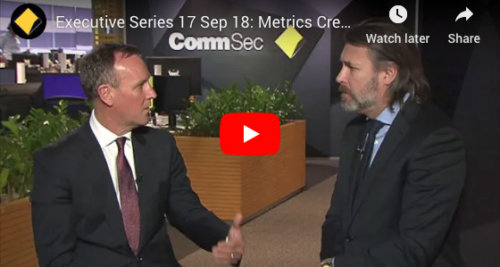Behind The Scenes With Metrics Credit Partners
Andrew Lockhart, Managing Partner, updates Fixed Income News Australia on the Metrics Credit business and explains why it’s different from others.
HOW IS THE BUSINESS GOING?
Business is going very well. Looking back over 2020, it certainly was an interesting year and not without its challenges. We had wanted to raise capital for the MCP Master Income Trust (ASX:MXT), but when the COVID-19 pandemic hit and unit prices were lower than net tangible assets (NTA), we put that plan on hold and instead returned investor capital. As the year progressed and the Reserve Bank of Australia (RBA) responded with cuts in interest rates and economic stimulus, the market gained confidence and we’ve seen very strong investor capital inflows over the last 12 months.
From a credit risk management perspective, with increased business and economic risk, we were naturally more conservative from March to July and focussed more on existing borrower relationships. We had exposure to residential and industrial development construction sites and were concerned about supply chain disruption and the capacity to build on time and on budget. There were risks associated with potential asset price declines and rising settlement default risk. It was also a process of understanding the liquidity risk to determine if our borrowers would be impacted. No one predicted a government shutdown and border closures. It was a severe stress test!
We worked closely with our borrowers and made sure they were engaged with the unions and following appropriate workplace health and safety plans.
However, we were well positioned in terms of our portfolio makeup. We’ve been in the market for 30-40 years and have seen many other market cycles. So, we have stayed away from and are not exposed to the higher risk sectors, such as student accommodation and discretionary retail, where you have more volatility in cashflows and earnings.
Our businesses adapted to the changing government policies, and the government was very proactive during that time with a lot of announcements, plans, policies and stimulus to increase economic activity. We talk to our borrowers about their businesses years in advance and are already talking beyond 2023-2024.
We are in the fortunate position that we can select companies we want to deal with. Despite continued inflows into our funds, the lending opportunities in the market outweigh the capital we have available, so we recently increased our direct marketing.
We lend to four groups:
- ASX listed and large private companies
- Project and infrastructure borrowers
- Commercial real estate (CRE) – this has mostly been short term development finance, like residential land subdivisions and residential high rise/medium density developments in Sydney and Melbourne where there’s been growth and demand is strong; and
- Acquisition finance – we do a lot of transactions with private equity firms.
HAVE THE BANKS BEEN MORE AGGRESSIVE WITH ALL THE CHEAP MONEY IN THE SYSTEM?
The banks are most active in lending to ASX-listed investment-grade corporates and project and infrastructure finance because they get a capital benefit. Any borrower who is sub investment grade or where the banks are overexposed, such as CRE, you find pockets of illiquidity, but there hasn’t been any material change for pricing since pre-COVID.
Investment grade credit spreads are pretty tight, so this part of the market isn’t necessarily the most attractive space to lend.
We continue to see borrower frustration with the time it takes to finance a deal. The banks aren’t really set up for remote lending and getting deals approved. They are looking at providing multiple financial services and are not set up to act quickly, but we have a different relationship, focussed on the business, and aren’t interested in a broader transactional banking relationship – we just want to lend.
WHY INVEST IN METRICS COMPARED TO SAY A CONSUMER CREDIT FUND?
In the case of consumer credit funds, their lending is often highly leveraged residential mortgages that are then securitised. If you want to withdraw your capital from one of the funds, the return of that capital is dependent on consumers repaying their loans.
At Metrics, all our funds are unleveraged, and our business is only focused on commercial lending. We don’t lend to consumers or to the small-to-medium enterprise part of the market, only to larger corporates with diversified business models and sustainable cash flows. Meanwhile, the listed fund structure allows investors to buy and sell shares on the ASX with same-day settlement just as they would equities.
Corporate loans are one of the few asset classes that offer attractive returns as well as capital stability, something that investors have increasingly been searching for in the current low yield environment Our business model has been built with the end investor in mind. We’re trying to get attractive returns for them, and we are focused on total return and the pricing outcome to the borrower.
Whatever we earn in interest and fees charged to borrowers is paid to investors less our management fees. The business model for the end investor is quite different to a consumer credit fund. They are usually trying to generate an excess spread over the cost of their funding. That is a net interest margin in the transaction rather than paying the full return to the investor.
As for global high yield bonds, I would question why an Australian retail investor would invest in that market where there is a lot more volatility and the investment is not defensive. Investors receive no benefit of Australian corporate or insolvency laws and are exposed to higher credit risk and volatile foreign currency movements.
Two reasons that investors should consider Metrics:
- Our credit skills and our ability to manage risk and originate loans.
- We negotiate on clients’ behalf the appropriate return for the risk.
WHAT HAS BEEN YOUR EXPERIENCE WITH ARREARS IN YOUR FUNDS?
We have more than 140 borrowers with over $6 billion in funds under management. Loans are a mix of investment and sub investment grade and go from senior unsecured all the way down to equity in the capital structure. Historically, we’ve completed more than $10 billion and over 350 transactions since June 2013. In this time, four borrowers have needed workouts or credit restructuring and there has been no credit loss or operational loss and currently there are no borrowers in arrears on principal or interest on any funds.
Even throughout 2020, when pandemic-related restrictions meant many Australian corporates experienced severe disruptions to their revenue, there were no arrears or defaults across our portfolio.
CAN YOU PROVIDE AN EXAMPLE OF A RESTRUCTURED CREDIT?
We had lent $14 million for an apartment development on a 65% loan-to-valuation ratio. After 12 months, the developer hadn’t got the agreed pre-sales, so we asked for repayment. We took no enforcement action but extended the contract by three months for a fee and charged a higher interest rate. We worked with the borrower to refinance the existing loan and he negotiated a sale over the site in the three-month timeframe. The developer sold for $25-$26 million and we were fully repaid. It was a forbearance facility. There was no enforcement of our rights and investors were not exposed to risk of any loss.
WHO INVESTS IN METRICS’ FUNDS?
Of our $6 billion in FUM, just under $2 billion is from 26,000 retail investors who hold units in our ASX-listed funds. For the unlisted funds, our business focus is direct marketing to financial planners and institutional investors and talking to them about the investment case. It’s typically a client-advised product and financial planners have access through approved product platforms.
On the institutional side, it’s predominantly Australian institutions comprising large retail-fund of fund groups, insurers and superannuation providers, charities and universities. Approximately $4 billion is from institutional investors.
WHAT ARE YOUR EXPECTATIONS FOR 2021?
Based on the conversations we’ve had with clients and businesses to date, their FY2021 forecasts are projected to be higher than FY2019, which is encouraging.
This year we’ll reconsider the capital raising and expand our Victorian office.
We also plan to launch a fund in New Zealand for wholesale investors and target offshore investors.
DO YOU HAVE ANY CONCERNS ABOUT INCREASING REGULATION OF THE SECTOR?
In broad terms, non-bank residential consumer mortgage lending is a significant part of the market and I understand why the regulators would deem them systematically important. The loans are heavily geared in warehouse and RMBS issuance. In contrast, Metrics raises equity capital from diverse sources, and our funds are not leveraged and we do not lend to consumers.
Because our funds are not geared, there is less risk in our funding and business model, giving investors choice and generating superior returns. We also provide a diversified funding source of non-banking capital for companies.
DO YOU HAVE ANY DOWNSIDE PROTECTION IN PLACE FOR ANY OF THE FUNDS?
We don’t hedge our positions using credit default swaps or other derivatives. We manage credit risk through the diversification of our portfolio across industry sectors and through covenants.
Our assets are tested each month and we mark to market the funds. KPMG run all the various credit loss scenarios before audit sign-off. We take governance and obligations to investors very seriously. If there is any risk of loss and it is known to us, we would adjust the net asset value (NAV) immediately. In the last eight years, we haven’t sustained any losses.
METRICS PRODUCTS
Metrics has two ASX-listed funds:
Australia’s first ASX-listed corporate loan fund and the country’s largest credit LIT, MXT was launched in October 2017.
Designed to offer an alternative to defensive traditional fixed income asset allocation, the fund has a current NAV of $1.28 billion. The trust invests in the Australian corporate debt market and targets a net of fees return of the RBA cash rate plus 3.25% p.a. (currently 3.35% p.a. net of fees) through the economic cycle. Income is paid monthly and since listing, the fund has outperformed, delivering a net return of 5.31%* p.a.
This fund is available as an alternative to equities. It first listed in April 2019 and has a current NAV of $350 million. The trust invests in a portfolio of private credit investments and targets a cash yield of 7% p.a. with an over the economic cycle target return of between 8-10% p.a., net of fees and expenses.
It lends to sub investment grade borrowers in different parts of the capital structure and has a lower risk position versus outright equity. The thought was that we could provide investors with 7% p.a. monthly cash income, while taking equity-like risk but without the volatility in share price, providing better capital stability.
To date, the trust has delivered a return of 7.55%* net of fees and costs since inception. Over time, if we’re successful, some of the investments will deliver a capital gain that will provide investors with an even higher total return.
Metrics also have a direct unlisted debt fund, Metrics Direct Income Fund (MDIF), which is very similar to MXT but gives investors the option to trade at NAV with possible monthly liquidity.
For more on Metrics, visit metrics.com.au
*MXT performance relates to the period 9 October 2017 – 31 January 2021. MOT performance relates to the period 29 April 2019 – 31 January 2021. Performance assumes participation in Distribution Reinvestment Plan (DRP). Past performance is not a reliable indicator of future performance.
About Metrics’ Managing Partner Andrew Lockhart
Andrew has more than 30 years’ banking, funds management and financial markets experience specialising in leverage and acquisition finance as well as corporate and institutional lending. Andrew’s considerable experience includes being responsible for the origination and portfolio risk management of large, diversified and complex loan portfolios including corporate restructurings. Andrew holds a Bachelor of Business and Masters of Business Administration from the Queensland University of Technology.
Other News
Research Paper: Six Trends for Private Credit in 2026
Metrics Credit Partners has released its latest research paper, Six Trends for Private Credit in 2026, exploring the opportunities and challenges…
Metrics Innovate Reconciliation Action Plan
We are proud to share our second Reconciliation Action Plan (RAP), reaffirming our commitment to truth, healing and unity. We…
INSIGHTS
MCP Income Opportunities Trust (MOT) lists on ASX
Sydney, 29 April 2019: The Trust Company (RE Services) Limited (ABN 45 003 278 831) (Responsible Entity) is the responsible…
MCP Master Income Trust wins Lonsec Listed Fund Award
The award came a year after MXT was listed on the Australian Securities Exchange






